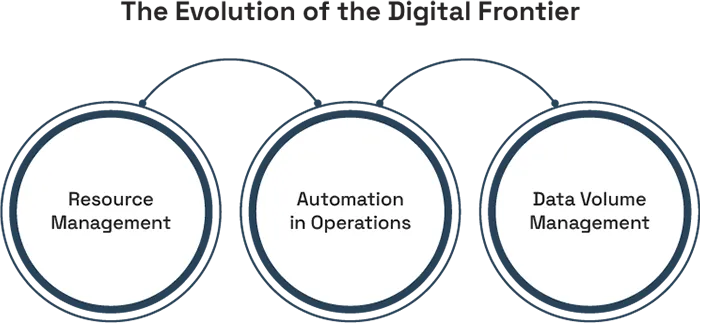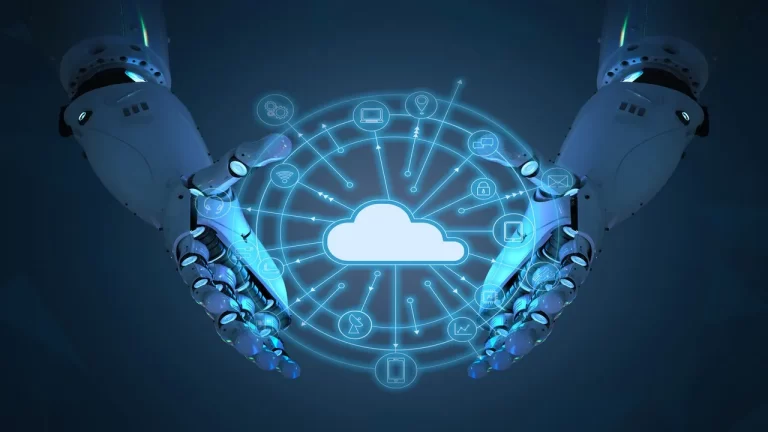The advances of such technologies including AI and cloud computing are increasing their role in our daily lives have affected the method of storing and accessing data for a certain period. From improving the efficiency of data centers in the cloud computing environments to improving the sustainability of infrastructure AI is a revolutionary technology. As the need for better, quicker, and smarter systems increases, AI is driving a quiet but powerful revolution behind the scenes.
The Evolution of the Digital Frontier
With the shift in the implementation of business and government databases and virtual solutions into cloud computing service environments, artificial intelligence has become the driving tool to lead and navigate operations. What was initially used mostly in supporting some forms of resource management is now a key to identifying wastes, optimal resource use, and expected needs. This is especially true in hyperscale cloud computing data centers where density and automation define scalability.
Cloud service provider giants such as Google, Amazon, and Microsoft are particularly using AI to improve their respective hyper scale computing companies’ data center. These systems must handle huge amounts of data and act as millions of users as well as provide immediate services all around the world. AI makes the sort of scaling and energy usage optimization necessary to accommodate such needs and keep everything running.

Smart Management in Modern Data Centers
AI is not just a tool it is becoming the digital brain of the data center. With its help, administrators can manage workloads, monitor heat generation, and fine-tune energy usage.
Using hundreds of sensors in a facility, it is possible to predict failures, optimize loading, and decrease costs. These capabilities are in harmony with current and future sustainability trends within data centers to minimize carbon use and provide sustainable energy.
Current and present data center cloud networks are faster and complex as compared to former ones. The use of AI means that the AI is flexible to congestion, bottleneck areas and provides efficient traffic rerouting. This means that whatever one needs is in the digital platform, such as storage, media streaming and operating virtual machines will run efficiently and uninterrupted.
Virtual Intelligence in Cloud Environments
In the world of virtual data center in cloud computing, AI is a catalyst for innovation. Machine learning models process vast datasets to optimize how virtual resources are allocated and scaled. These smart systems adjust in real-time based on user demand, application behavior, or even external conditions like power availability or cooling capacity.
A great example is Grok AI, which is being used in some cloud computing centers to analyze infrastructure health and reduce downtime. It doesn’t just react to problems—it predicts them, which is a massive advantage in a world where even seconds of downtime can cost companies millions.

AI and Scalability in Cloud Platforms
Scalability is the backbone of data center and cloud computing models. AI enables platforms to transmit data efficiently, allocate resources dynamically, and increase operational capacity without the need for human intervention. It powers the orchestration of containers, virtual machines, and services across thousands of servers.
In public cloud data centers this allows for seamless scaling during high traffic periods. Think of tax season, online retail surges, or viral content spikes. AI ensures these spikes are handled with minimal latency and maximum reliability. That’s the kind of invisible infrastructure magic that supports the digital age.
Keeping Up with Trends and Security
According to data center industry trends, cybersecurity is another area where AI is proving its worth. In today’s connected environment, threats evolve quickly. AI-based systems can detect unusual behavior in real-time, identify risks, and neutralize threats before they cause damage.
As data center trends point toward automation and autonomy, AI also enables smarter compliance monitoring. By analyzing docs (documents and metadata) flowing through a system, AI can ensure regulatory policies are followed, reducing legal risk and ensuring smoother audits.
A New Era of Efficiency
From predictive maintenance to smart cooling systems, the benefits of AI in cloud computing are substantial. It minimizes energy waste, improves service reliability, and enhances customer experience. These advantages are critical as the world demands more responsive and responsible digital infrastructure.
Governments too are recognizing the benefits. Initiatives to modernize IT infrastructure are increasingly focusing on AI-powered database center upgrades, cloud migration, and automation.
Conclusion
Artificial intelligence is not a just keyword nowadays; it is the actual trend in today’s complex world of technologies which is helping to act green smart and responsive. From supporting the World Wide Web and cloud-based data centers to the way information propagates in a network, it is AI to the rescue. As we stand at the frontier of innovation, the blend of intelligent software and agile infrastructure is shaping the future of computing one smart decision at a time.








